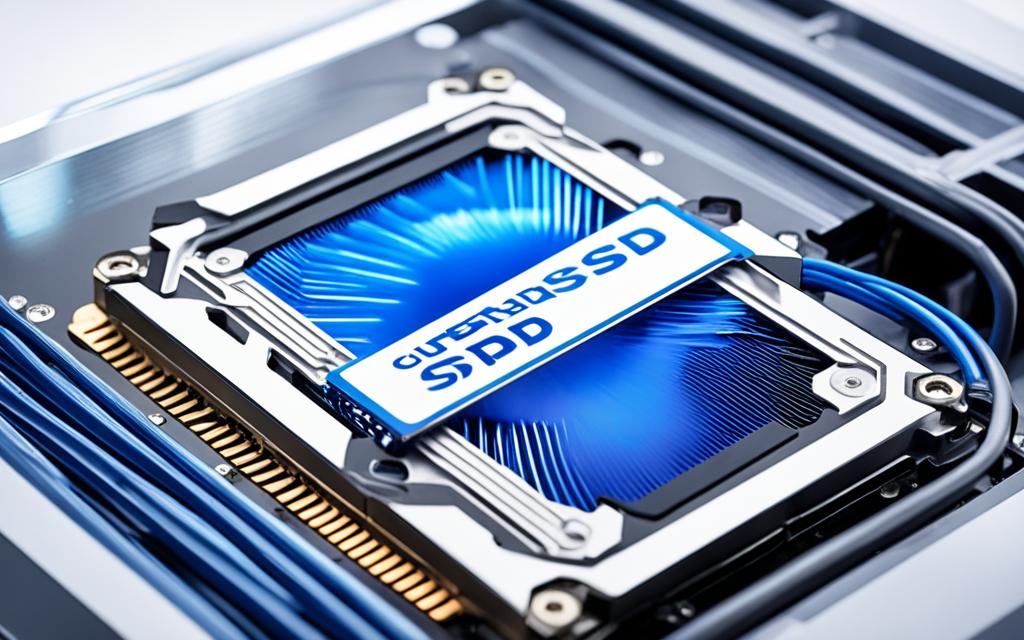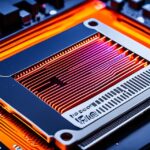Table of Contents
The need for an SSD heatsink is becoming more crucial due to the advanced requirements of today’s technology, especially for NVMe SSDs. These drives get very hot under heavy use, which can hurt their performance and lifespan. By using good cooling methods like heatsinks, we can prevent overheating. This ensures the controller stays at the right temperature.
Not everyone will need a heatsink. But, for people who often move a lot of data, like professionals and gamers, it’s very helpful. Cooling systems help the SSD work at its best. They also protect it from damage caused by too much heat. This is very important for maintaining top performance under heavy load12.
Key Takeaways
- Using an SSD heatsink can greatly help with controlling heat and extending device life.
- NVMe drives get hotter and might need extra cooling compared to traditional SSDs.
- If SSDs get too hot, they could perform worse and you might lose data.
- Many SSDs have built-in heatsinks, and using active or passive cooling can boost their function.
- Heatsinks are especially useful for users who regularly deal with big amounts of data.
Understanding the Basics of SSDs
The rise of the Solid-State Drive (SSD) has changed how we save data. Unlike old hard drives, an SSD uses NAND flash memory. This makes it faster to read and write data. Because of their speed, SSDs are great for high-performance needs like gaming and quick boot times. They play a big role in upgrading or building new computer systems.
What is an SSD?
An SSD, short for Solid-State Drive, is a storage device without moving parts. It uses flash memory to store data, making it quicker and more reliable than old hard drives. Thanks to these features, SSDs meet the need for fast data access. They’re used in everything from web browsing to playing big games.
Components of an SSD
It’s helpful to know what’s inside an SSD to understand how it works and why it gets hot. An SSD has a controller chip, DRAM cache, and NAND flash memory. Most SSDs use the M.2 format that connects to the motherboard. They use NVMe and PCIe interfaces, including the fast PCIe Gen43. These features mean SSDs can get hot and may need heatsinks to stop them from slowing down during intense tasks like gaming or video editing3.
SSD technology keeps improving to meet user needs, from everyday tasks to demanding applications. Their development shows how vital data storage has become. It enables smoother performance across different digital activities.
If you need help with choosing and using an SSD, check out this guide. It covers common questions and helpful tips3.
Why Do SSDs Generate Heat?
It’s important to understand why SSDs get hot to keep them running well. When SSDs transfer data, they often get very warm. This heat comes from the parts inside working hard, especially when they’re under a lot of pressure.
Data Transfer and Heat Production
Data moving around is a big reason why SSDs get hot. NVMe SSDs can get up to 80°C when they’re really busy4. They’re supposed to work between 0°C and 70°C4. If they get too hot, it can hurt the data inside and shorten the SSD’s life, says a Facebook study4. Keeping the SSD cooler than 50°C helps it last longer4.
Factors Affecting SSD Temperature
Several things can make SSDs hot. For example, PCIe 5.0 SSDs use a lot of power, which makes them hot5. Without the right cooling, like a heatsink, they can fail or shut down because of the heat5. Luckily, many motherboards for PCIe 5.0 SSDs have heatsinks built in to help cool them down5. Still, sometimes those small M.2 heatsinks on some boards aren’t big enough, so you might need something better from the market to keep the heat in check4.
What is a Heatsink?
A heatsink is vital for keeping electronic devices, like SSDs, cool. It absorbs and disperses heat, ensuring SSDs work at their best. This is crucial as M.2 NVMe SSDs, which are faster and hold more data, become more common6.
How Heatsinks Function
Heatsinks draw heat away from the device and spread it out. They have a big surface area to discharge heat into the air. Keeping temperatures safe is key; over 80°C is too hot, but under 50°C is ideal for longer SSD life4. Heatsink designs differ, with passive cooling using natural airflow and active cooling using fans or liquids.
Types of Heatsinks Available
There are several heatsinks, made for different SSDs. Some have metal sticker heatsinks for better heat distribution6. The SSD’s speed and storage size guide the choice of a heatsink. Some SSDs don’t need them for daily tasks, but many include them for efficiency and looks. Good airflow in a PC also helps without a dedicated heatsink4.
Choosing the right heatsink is key for SSD performance and dependability. It helps users get the most from their storage tech6.
Do SSDs Require a Heatsink?
When looking into heatsinks for SSDs, you need to think about how much you use them. SSDs can work without a heatsink, but they might run into trouble when they get too hot. High heat can cause them to slow down to keep from overheating. This can hurt their performance and shorten their life. People who do a lot of gaming or work with lots of data should consider cooling to keep their SSDs fast and reliable.
Performance Implications of Not Using a Heatsink
Not having a heatsink can lead to big problems. For instance, PCIe 5.0 drives can get very hot due to how much power they use. Without good cooling, this heat can cause serious errors or make the system shut down to prevent damage5. So, if you’re using a high-performance SSD, it’s wise to follow what the manufacturers say. They advise setting up your device in a way that prevents it from getting too hot. This helps avoid losing data or damaging your hardware.
Manufacturer Recommendations for Heatsinks
Top manufacturers suggest using heatsinks with SSDs, especially the fast ones. Sony, for example, recommends a heatsink SSD for the PlayStation 5. This is to make sure the SSD doesn’t overheat7. If you want your computer to work better for longer, think about whether a heatsink could help your SSD. To make further improvements, see tips on keeping your system in top shape here.
FAQ
Do all SSDs need a heatsink?
Not all SSDs need a heatsink. But, it’s a good idea for NVMe drives that work hard and get hot. Doing this helps keep them cool and run better.
What benefit does a heatsink provide to an SSD?
A heatsink takes away heat from the SSD during use. This keeps the SSD’s controller at a safe temperature. It can make the drive perform better and last longer.
How can I monitor my SSD’s temperature?
To check your SSD’s temperature, you can use tools like CrystalDiskInfo or HWMonitor. They show you the temperature and how well your SSD is doing in real-time.
What are the signs that my SSD might be overheating?
If your SSD gets too hot, it may slow down a lot. You might see errors when moving files. Also, the drive might cut its speed to cool down.
What types of heatsinks are available for SSDs?
SSD heatsinks vary a lot. Some use the air around them to cool down without fans. Others use fans or even liquid to get rid of heat better.
Should gaming PCs always use heatsinks for SSDs?
For gaming PCs, using a heatsink is a smart choice. Games often move lots of data, creating heat. This heat can lower your SSD’s efficiency if not managed well.
Can using a heatsink affect the SSD installation process?
Adding a heatsink might change how you install the SSD a bit. You’ll need more room and to line things up right for the best heat transfer. Yet, it’s usually easy if they fit together well.
Source Links
- https://www.crucial.com/articles/about-ssd/do-you-need-an-nvme-ssd-heatsink – Do you need an NVMe SSD heatsink?
- https://www.easeus.com/computer-instruction/do-i-need-a-heatsink-for-my-m2-ssd.html – Do I Need a Heatsink for My M.2 SSD [2024 Full Guide]
- https://blog.westerndigital.com/ssd-heatsink-hot-storage-cool-data-m2/ – SSD Heatsink: Hot Data, Cool Storage
- https://www.minitool.com/lib/m2-heatsink.html – What Is M.2 Heatsink? Do NVMe SSDs Need Heatsinks? – MiniTool
- https://www.xda-developers.com/pcie-5-ssd-need-heatsink/ – Do I need a heatsink for PCIe 5.0 SSDs?
- https://www.makeuseof.com/what-is-m2-nvme-ssd-heatsink/ – What Is an M.2 NVMe SSD Heatsink?
- https://www.playstation.com/en-us/support/hardware/ps5-install-m2-ssd/ – How to add an M.2 SSD to a PS5 console (US)








